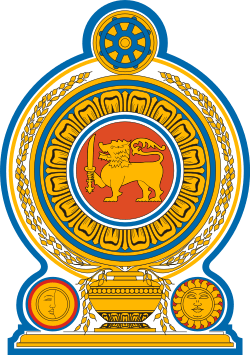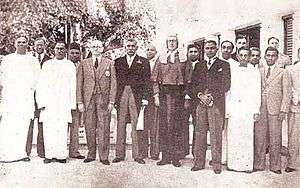Prime Minister of Sri Lanka
| Prime Minister of Sri Lanka ශ්රී ලංකා අග්රාමාත්ය இலங்கை பிரதமர் | |
|---|---|
 | |
 | |
| Style |
Mr. Prime Minister (Informal) The Honourable (Formal and diplomatic) |
| Member of |
Cabinet National Security Council Parliament |
| Reports to | Parliament |
| Residence | Temple Trees |
| Seat | Sri Jayawardenapura Kotte |
| Nominator | Parliament of Sri Lanka |
| Appointer | President of Sri Lanka |
| Term length | Five years |
| Constituting instrument | Constitution of the Democratic Socialist Republic of Sri Lanka |
| Precursor | Leader of the House, State Council of Ceylon |
| Inaugural holder | Don Stephen Senanayake |
| Formation | 14 October 1947 |
| Succession |
First in the presidential line of succession |
| Salary | LKR 858,000 annually (2016)[1][2] |
| Website | Prime Minister's Office |
 |
|---|
| This article is part of a series on the politics and government of Sri Lanka |
|
|
Executive
|
|
|
|
Foreign policy |
|
Related issues
|
The Prime Minister of the Democratic Socialist Republic of Sri Lanka (Sinhalese: ශ්රී ලංකා අග්රාමාත්ය Śrī Laṃkā agrāmāthya; Tamil: இலங்கை பிரதமர்) is the most senior member of parliament in the cabinet of ministers in Sri Lanka which is collectively accountable for their policies and actions to parliament. The President is both head of state and head of government in Sri Lanka. Since 1978, most prime ministers have served as mere deputies to the executive presidency, while at times served as the de-facto head of government. The current holder of the office, Ranil Wickremesinghe, leader of the United National Party, was appointed by Maithripala Sirisena on 9 January 2015. This was the third time that Wickramasinghe was appointed Prime Minister of Sri Lanka.
Appointment
The president will appoint a member of parliament as prime minister, who in the President’s opinion, "is most likely to command the confidence of Parliament". The prime minister will continue to hold office throughout the period during which the cabinet of ministers continues to function under the provisions of the constitution unless he/she resigns from the post or ceases to be a member of parliament.[3]
Powers and role
Under the Soulbury Constitution the post of Prime Minister was created in 1947 as the head of government in the Westminster system. In 1978, under the second amendment to the Republican Constitution of 1972 much of the powers of the premiership was transferred to the executive presidency as head of government and head of the cabinet of ministers in addition to being the head of state. As a result the Prime Minister became a senior most member cabinet of ministers and successor to the President. The prime minister would serve as the deputy to the president if both are from the same political party. In certain occasions, when the president is not from the majority party in parliament or a national government is formed, the prime minister would be appointed from a party different to the president. In such a situations the prime minister would serve as the de-facto head of government.[3] In 2015, the nineteenth amendment restored certain degree of powers to the premiership.
The prime minister is the second in the order of precedence after the president and head of the cabinet of ministers. The prime minister would be a member of the constitutional council, national security council and the senior most member cabinet of ministers.
Head of the cabinet of ministers
As head of the cabinet of ministers, the Prime Minister has the power to:
- Determine the number of Cabinet Ministers and Ministries and assignment of subjects.
- Determine the number of Non-cabinet Ministers and Ministries and assignment of subjects.
Principal adviser to the president
By the constitution, the Prime Minister holds formal power to advise the president on:
Presidential succession
As per the constitution, if the office of president becomes vacant, the prime minister would "act in the office of President during the period between the occurrence of such vacancy and the assumption of office by the new President and shall appoint one of the other Ministers of the Cabinet to act in the office of Prime Minister". In such as situation, the office of Prime Minister is vacant or the prime minister is unable to act, the Speaker shall act in the office of President.[3]
The president may appoint the prime minister to exercise, perform and discharge the powers, duties and functions of the office of President for a period during the president is unable to exercise, perform and discharge the powers, duties and functions of his office due to illness, absence from Sri Lanka or any other cause.[3]
Privileges of office
Salary
The Prime Minister would receive a salary (as of 2016) of LKR 858,000 annually paid from the Prime Minister's Office.
Official residence and office
The official residence of the prime minister is the Prime Minister's House most commonly referred to as Temple Trees. The Prime Minister's Office is located on Sir Ernest de Silva Mawatha (formerly known as Flower Road) in Colombo.
In recent years from time to time, Temple Trees has been by some presidents such as Kumaratunga and Rajapaksa. While certain Prime Ministers such as Wickremesinghe have chosen to stay at his personal residence.
Travel
For ground travel, the prime minister uses the prime ministerial car, which is an armored black Mercedes-Benz S-Class (S600) Pullman Guard. For domestic air travel, helicopters from the No. 4 (VVIP/VIP) Helicopter Squadron of the Sri Lanka Air Force are used while for long distance travel, regular flights of the Sri Lankan Airlines are used.
Security
Traditionally security for the prime minister has been provided by the Sri Lanka Police. During emergencies military units have been allocated to bolster security. At present the Prime Minister's Security Division is in charge of security of the Prime Minister.
History

The post of Prime Minister of Ceylon was created in 1947 prior to independence from Britain and the formation of the Dominion of Ceylon in 1948. United National Party leader D. S. Senanayake became the first Prime Minister of Then Ceylon in 1947 after independence. In 1972 when Sri Lanka became a republic the name of the post changed to Prime Minister of Sri Lanka. With a Westminster-based political system established the Prime Minister was the head of government therefore held the most powerful political office of the country at the time. This changed with a constitutional change in 1978, when the Executive Presidency was created, making the President both head of state and head of government. Until 1978 the Prime minister was also the Minister of Defence and External Affairs. The Prime Minister is appointed by the President as a member of the cabinet of ministers. In the event the post president is vacant, the Prime Minister becomes the acting president until Parliament convenes to elect a successor or new elections could be held to elect a new president. This was the case with H.E. President Dingiri Banda Wijetunge. United National Party leaders Dudley Senanayake and Ranil Wickramasinghe together with Sri Lanka Freedom Party leader Sirimavo Bandaranaike was appointed three times to the position. With passing of the 19th amendment to the constitution in 2015, the prime minister was granted more powers when appointing ministers and leading the cabinet.
Last election
List of Prime Ministers
See also
Notes
- ↑ The UNFGG contested under the name and symbol of UNP.
- 1 2 The ACMC contested separately in one district (Ampara) and with the UNFGG in other districts.
- 1 2 The SLMC contested separately in two districts (Batticaloa and Vanni) and with the UNFGG in other districts.
- 1 2 The CWC contested separately in three districts (Badulla, Kandy and Kegalle) and with the UPFA in other districts.
- ↑ The CF contested separately in two districts (Nuwara Eliya and Vanni) and with the UPFA in other districts.
- ↑ The LP contested separately in four districts (Colombo, Galle, Kurunegala and Matara) and with the UPFA in other districts.
- ↑ The TNA contested under the name and symbol of ITAK.
- ↑ The TNPF contested under the name and symbol of ACTC.
References
- ↑ Thomas, Kris (21 November 2016). "Of Ministers' Salaries And Parliamentary Perks". Roar.lk. Retrieved 30 August 2017.
- ↑ Thomas, Kavindya Chris (20 November 2016). "Do MPs get fat salaries?". Ceylontoday.lk. Ceylon Today. Retrieved 30 August 2017.
- 1 2 3 4 5 6 The Constitution of the Democratic Socialist Republic of Sri Lanka
- ↑ "Parliamentary Election - 17-08-2015 - Official Election Results — All Island Results". Department of Elections, Sri Lanka.
- ↑ "Parliamentary Election - 17-08-2015 - Official Election Results — Composition of the Parliament". Department of Elections, Sri Lanka.
External links
- Parliament of Sri Lanka - Handbook of Parliament, Prime Ministers
